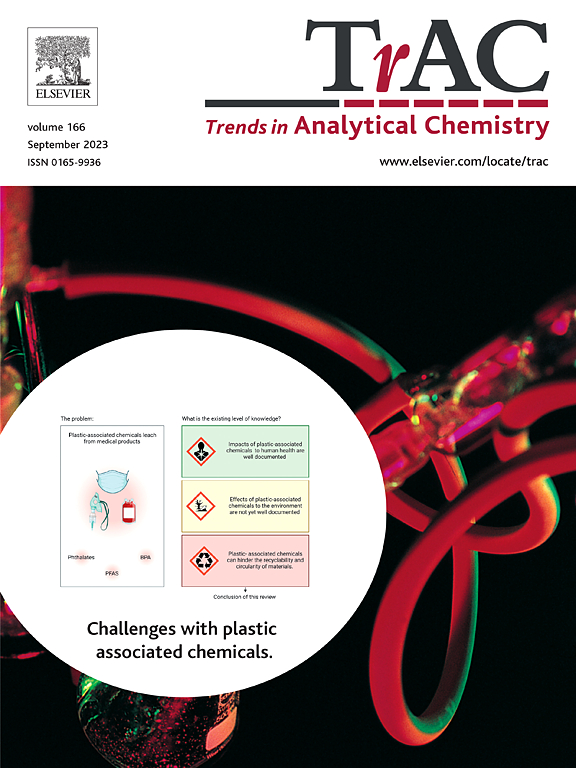用于测定环境液体样品中新出现污染物的磁基微萃取系统
IF 12
1区 化学
Q1 CHEMISTRY, ANALYTICAL
引用次数: 0
摘要
在过去的十年中,基于功能化磁性纳米颗粒(MNPs)提取新兴污染物(ECs)的新方法的发展有所增加。这些材料的特性允许通过磁场应用快速有效地分离用作萃取剂的吸附剂和/或溶剂,避免使用耗时和昂贵的过程。由于其高表面积,易于与不同材料改性,并且与传统固相萃取系统集成,这种纳米吸附剂是开发高效微萃取方法的候选者。此外,它们可以很容易地自动化,并符合绿色化学原则,减少纳米颗粒合成及其后续应用中产生的环境影响。这篇重要的综述集中在过去10年中用于测定液体环境基质中ECs的MNPs复合材料微萃取系统中的应用,包括药品,个人护理产品,增塑剂和工业化学品以及微塑料。本文章由计算机程序翻译,如有差异,请以英文原文为准。

Magnetic-based microextraction systems for the determination of emerging contaminants in environmental liquid samples
The development of novel methodologies for the extraction of emerging contaminants (ECs) based on functionalized magnetic nanoparticles (MNPs) has increased over the past decade. The properties of these materials permit rapid and efficient separation of the adsorbents and/or solvents used as extractants by the application of a magnetic field, avoiding the use of time-consuming and expensive processes. Due to their high surface areas, ease of modification with different materials, and integration with conventional solid-phase extraction systems, such nanoadsorbents are candidates for developing efficient microextraction methods. Furthermore, they can be easily automated and aligned with green chemistry principles, reducing the environmental impact generated in the synthesis of the nanoparticles and their subsequent application. This critical review focuses on the use of MNPs composites in microextraction systems employed for the determination of ECs in liquid environmental matrices over the past 10 years, including pharmaceuticals, personal care products, plasticizers and industrial chemicals and microplastics.
求助全文
通过发布文献求助,成功后即可免费获取论文全文。
去求助
来源期刊

Trends in Analytical Chemistry
化学-分析化学
CiteScore
20.00
自引率
4.60%
发文量
257
审稿时长
3.4 months
期刊介绍:
TrAC publishes succinct and critical overviews of recent advancements in analytical chemistry, designed to assist analytical chemists and other users of analytical techniques. These reviews offer excellent, up-to-date, and timely coverage of various topics within analytical chemistry. Encompassing areas such as analytical instrumentation, biomedical analysis, biomolecular analysis, biosensors, chemical analysis, chemometrics, clinical chemistry, drug discovery, environmental analysis and monitoring, food analysis, forensic science, laboratory automation, materials science, metabolomics, pesticide-residue analysis, pharmaceutical analysis, proteomics, surface science, and water analysis and monitoring, these critical reviews provide comprehensive insights for practitioners in the field.
 求助内容:
求助内容: 应助结果提醒方式:
应助结果提醒方式:


